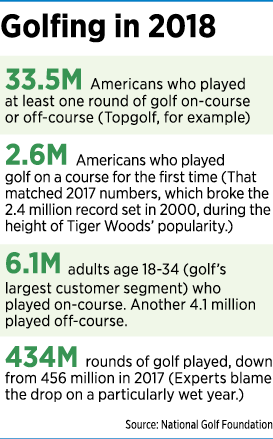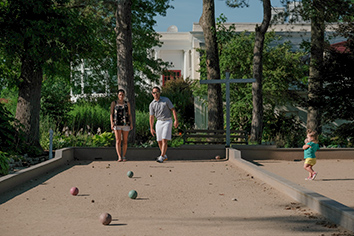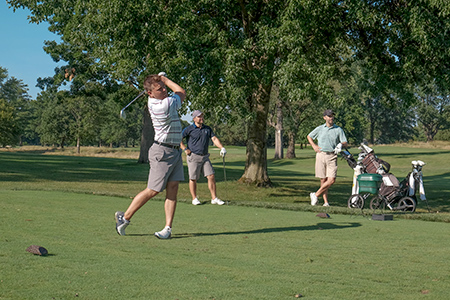Subscriber Benefit
As a subscriber you can listen to articles at work, in the car, or while you work out. Subscribe NowThe term “country club” might once have evoked stodgy images of older men sipping brandy and smoking cigars after a round of golf, but the membership at today’s clubs is younger and the activities more diverse than ever.
Think fitness classes, college nights with pool-side beer pong, and day camps and other activities for children. The amenities are meant to appeal to a younger—and more casual—generation.
The changes have come after a period in which interest in golf overall declined, pinching the membership and finances at many country clubs. In 2005, 30 million Americans played at least one round of golf, according to the National Golf Foundation, which tracks the sport. By 2013, that number had dropped to 24.7 million.
 It dropped a little further in 2018—to 24.2 million.
It dropped a little further in 2018—to 24.2 million.
But related golf activities are picking up, with some 9.3 million people last year taking part in off-course golf activities at places like driving ranges, indoor golf simulators or golf entertainment venues like Topgolf and Drive Shack.
And the biggest age group that participated in golfing activities last year was adults 18 to 34, with a combined 10.2 million of them playing the sport either on a course or at an off-course facility, according to the National Golf Foundation.
That means about 30% of all golfers last year were young adults.
As more millennials pick up clubs, country clubs have changed their business models—from relaxing dress codes to reducing membership pricing—to draw them in. At many clubs in Indianapolis—and beyond—those changes appear to be paying off.
Several local courses told IBJ their membership numbers are growing, and many of those new members are under 40.
That’s welcome news to golf courses and country clubs, which have spent several years struggling to remain competitive in a market over-saturated with playing options.
In the metro area, the owner of Hawthorns Golf Club in Fishers filed for bankruptcy in 2014 after one of its largest lenders filed a nearly $5 million foreclosure lawsuit against the club. Later that year, the club was sold to California-based Concert Golf Partners, which had submitted a reorganization plan calling for the elimination of debt, investing more than $1 million in capital improvement projects and funding a reserve account.
Other area country clubs reported decreased membership and revenue losses.
Today, however, experts say country clubs and golf will continue to be part of the Indianapolis landscape, as long as owners are willing to keep adapting to members’ and prospective members’ desires.
“I think that country clubs will be in existence long after we’re gone, but they’ll be different than they are now,” said Greg Sabens, general manager of Highland Golf and Country Club, on West 52nd Street near Michigan Road. “You’ve got to adapt to what the market wants.”
A family choice

At Highland, membership numbers are comparable to what they were 20 years ago, Sabens said.
The club is approaching 350 members after adding about 100—mostly people under 35—over the past 15 months, thanks in part to several new amenities and upgrades.
“We’ve been extremely successful over the past few years,” he said. “We’re actually really growing well.”
Over the past four years or so, Highland has renovated its entire facility, including updating its clubhouse and adding an indoor golf “short course” that allows members to play year-round.
New amenities are aimed at appealing to the entire family. Traditionally, joining a country club was largely the husband’s decision. Today, it’s a family choice, so clubs must offer amenities for the primary member’s spouse and children, Sabens said.
“Millennials are very family-centric,” he said. “They want something that everybody is going to enjoy.”
Statistics back up that assertion. In 2016, the Club Managers Association of America released a report aimed at helping its members understand what people age 23 to 38 were looking to gain from a country club membership.
The study found millennials are much more likely than other generations to want a place for quality family time as well as sports and socializing for their children. The report even suggested that clubs showcase their family amenities in any marketing materials.
At Highland, the club added pickle ball and paddle tennis; both have proven to be popular for members of all ages, Sabens said. Bocce ball is also popular among young couples, who often come to the club in the evening with friends for drinks and a few games, he said.
For children, the club has an active swim team that competes against other clubs and has a six-week summer camp called Camp Highland that includes swimming, golf and tennis—sports campers are likely to play the rest of their lives if they, too, join a country club.
The Meridian Hills Country Club, on Spring Mill Road at 71st, has rearranged dining spaces to offer age-specific dining rooms for children. Its Kids Club serves as a child care option and also offers other activities for children, said General Manager Steve Roper.
Matt Vaught, manager at Broadmoor Country Club, on West Kessler Boulevard just a half mile west of Highland Country Club, said adding any amenity that appeals to families is a win for clubs. His club’s investment in completely renovating the dining room and pool to make them more vibrant has paid off, he said.
More affordable
In recent years, many clubs have also introduced new pricing options to make memberships more accessible to prospective members.
Some offer discounts to members under 40; others provide financing options that make steep initiation dues more affordable. Eighty percent of respondents in the Club Managers Association of America study said they would be more likely to join a club if initiation fees were spread out among two or three payments rather than one lump sum. Locally, those initiation fees range from about $5,000 to $40,000.
At Woodstock Country Club, just south of West 38th Street between the Central Canal and Martin Luther King Jr. Drive, new members can finance initiation dues over three years. And the club is willing to extend that longer if necessary, said Manager Susan Schenkel. The club recognizes many young members might be in their first or second professional jobs and don’t have much discretionary income, Schenkel said.
The club offers a 50% discount to members whose parents or grandparents are already members.
That discount has drawn in millennial members, she said. Today, Woodstock has about 475 members, approximately the same number it’s had over the 16 years she’s worked there.
At Highland, members under 39 can join for a discounted price. If you join before turning 30, for example, the initiation fee is $1,500 and monthly dues are $337. For ages 35 to 39, those prices increase to $2,100 and $446, respectively.
When members turn 40, they must convert their membership to the regular Class A category and purchase a stock certificate. They also get voting rights, according to the club’s website.
Meridian Hills offers a similar pay structure, and members don’t have to begin paying their initiation fee until they turn 40.
“The idea is to get people in, get used to it, and, with their families, enjoy the club,” Roper said. “Then they continue to be a member for 20, 30, 40 years.”
Many clubs also offer social and athletic memberships, which are cheaper than a full golf membership (at Meridian Hills, the initiation fee for golf is $40,000, but the fee for a social membership is just $3,500) but give members a taste of being part of the club.
Offering such customized memberships is critical to attracting millennials, the Club Managers Association of America found.
‘You’ve got to do more’
Today, country clubs are running more of a social business than a golf business, Vaught, Broadmoor’s manager, told IBJ.
At Broadmoor, millennials represent a third of the membership.
“The days of making sure your shirt is tucked in and your shoes are tied are a little passe,” he said. “But you can’t just add babysitting and allow for jeans and think that is going to fix your business model. You’ve got to do more.”
At Woodstock, the club has also tried to gear social events to its younger members’ interests. It just hosted a college night at the pool with beer pong, volleyball and other pool games. Even the food—sliders, for example—was geared toward millennials, Schenkel said.
The club also introduced cardio tennis, geared toward millennials. And because younger members seem more interested in being socially conscious, the club has launched a series of speakers to talk about those types of issues, including a program about the White River Vision Plan.
The clubs have also had to change the way they look at golf. No longer is it advertised as a five-hour game, Vaught said. Even the PGA has been pushing nine-hole games.
“Golf is no longer about 18 holes, then dinner with your colleagues or clients,” he said. “It can be six holes or three holes or an hour on the range with your kids.”•
Please enable JavaScript to view this content.


Golf slumped during the period when GenX was 30-50, which makes sense since that cohort is the smallest of the three adult generations (in between Boomers and Millennials).
Now that the Millennials are reaching their mid-30s, there are a whole lot more 30-something people, so even with a lower percentage of the population interested in golf or country clubs, there are more people/families interested on an absolute basis.